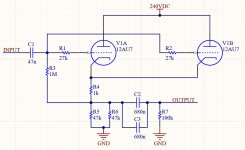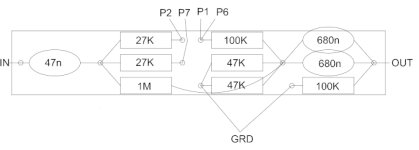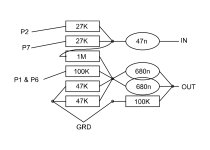Parallel Capacitors sum, so the 680n and 680n together is 1µ36.
So maybe Effectrode is achieving its exact target value by running parallel caps;
maybe they use that cap's value in other circuits and buying in bulk keeps the economies-of-scale balanced...
At any rate, C2 + C3 is straightforward.
What's interesting to me is that parallel resistors do NOT sum...
Do the math:
View attachment 39616
Rtotal = R5×R6/(R5+R6)
23k5= 47k x 47k / (47k + 47k)
OR
use an
online calculator = 23k5
Fine, but R3 (1M) is supplying some voltage and R4 (1k) with R5 (47k) has formed a voltage divider that feeds R6 (47k)...
So while R5 and R6 are parallel to each other going to ground, R3 and R4 are messing with the formula in ways I can't fathom. (I'm mathematically "illiterate")...
For power filtering a 100µ cap and 100n cap are sometimes used in parallel, why not just one big 1µ1 or 1µ2? I've read that the smaller cap handles small fast transients better (or something like that).
In the case of C2 + C3 above...
... I'm guessing that while you could just shove in one huge capacitor in place of C2 + C3;
I don't think you can just use a single resistor in place of R5 + R6, 'cause bearing in mind R3 and R4 — that would change the voltage being fed to C2+C3, no?




